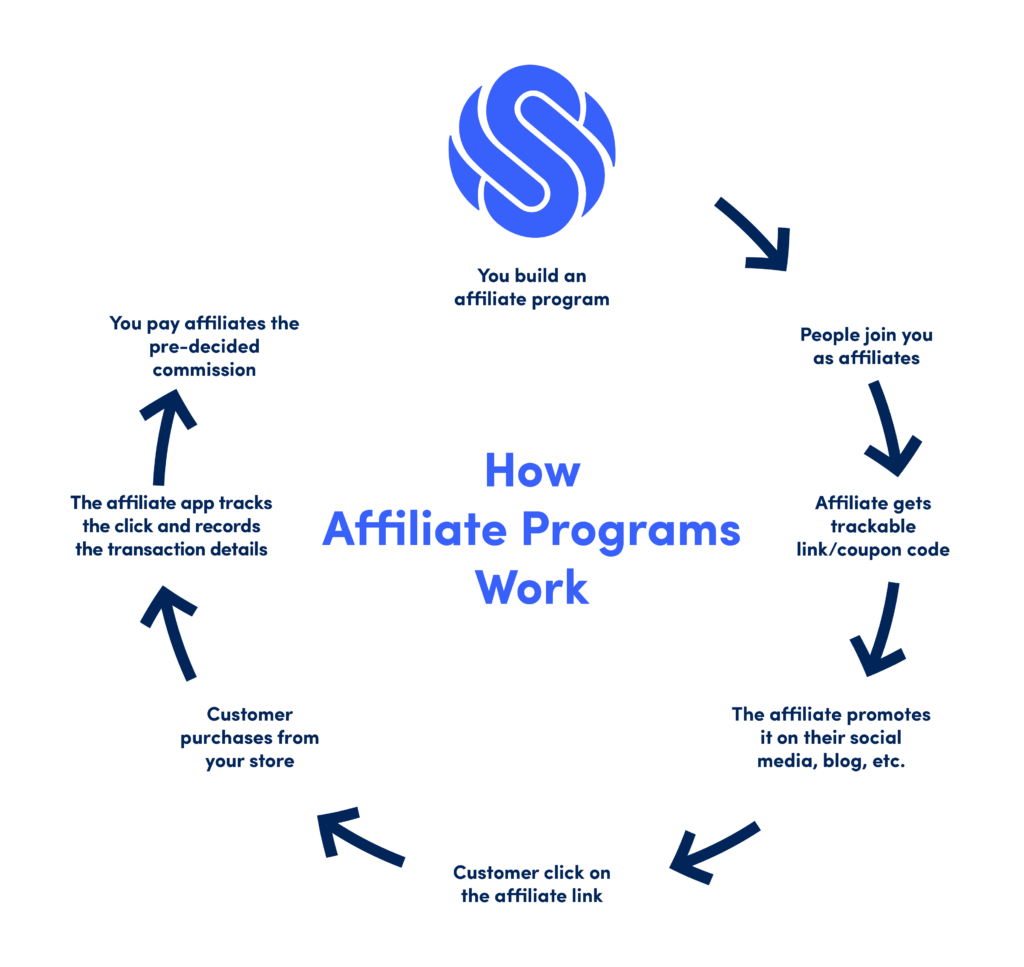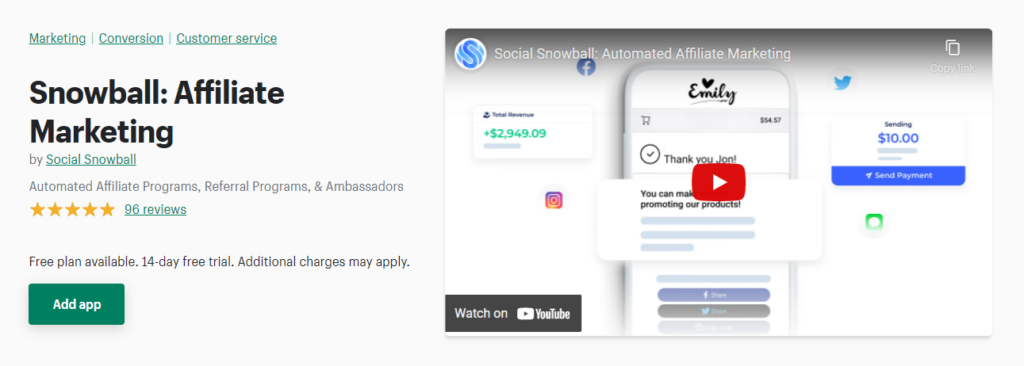More and more people are showing interest in affiliate marketing.

And it’s good news for all businesses with established affiliate programs. For them, it means more people will join them as affiliates, promote their products or services, and increase business revenue.
For you — someone who’s reading this “how to start an affiliate program for business” guide and yet to build an affiliate program — it’s great news as well. There’s an infinite supply of affiliates, and if your product/service is worth promoting and you build a worthwhile affiliate program, people would love to promote your brand.
Affiliate marketers are creating careers out of starting an affiliate marketing business and generating affiliate income outside of a regular day job. Many build an affiliate websites themselves. So, how can you take advantage of content creators looking to promote your products to their audience?
By creating an affiliate mar program and adding affiliate marketing partners, you can generate revenue at a guaranteed positive return on investment.
But how do you build a profitable affiliate program for your business without being an affiliate marketer? Well, that’s what you’ll learn in this article.
We’ll take you through the fundamentals of affiliate marketing and show you the steps to build a successful affiliate program. To be successful, you don’t need to have super involved in affiliate marketing–You just have to set up the basics.
Let’s start!
What Is Affiliate Marketing?
The term “affiliate marketing” can mean two different things depending on who’s asking.
For businesses, affiliate marketing means giving a reward (typically a fixed or % cash commission) for a sale/lead an affiliate brings to the business.
Then there’s the affiliate side. Affiliates are people who promote businesses’ products and services for a commission. These people can be business customers or professional influencers (like Instagram influencers or niche website owners).
For affiliates, affiliate marketing for small businesses means promoting a business’s offerings to earn a commission.
Wherever we mention “affiliate marketing” in this article or on the Social Snowball Blog in general, we mean it from the business’s perspective.
How Does an Affiliate Program Work?

You probably already understood the definitions of how an affiliate program works. Let us still lay it out for you step-by-step:
Step 1: You build an affiliate program
Step 2: People join it and become affiliates
Step 3: Affiliates get their affiliate links/coupon codes
Step 4: They promote your product(s) (or service(s)) and ask their audience to purchase through affiliate links
Step 5: A potential customer clicks on their affiliate link and purchases from you
Step 6: Your affiliate app/software/platform tracks the click & purchase and confirms the customer came through the affiliate
Step 7: You pay the affiliate a commission for the customer they brought
Then, repeat: The affiliate brings another customer > You pay the commission again.
A Quick View At The Benefits Of an Affiliate Marketing Program
Check out our benefits of affiliate marketing article for a detailed look at the affiliate program benefits. Here’s a summary:
1. Low-risk, high reward
Affiliate marketing is a performance-based marketing strategy. It essentially means you only pay the affiliates for the customer (or client) they bring to you — that, too, after the customer pays you and is past their refund/trial period. Moreover, setting up an affiliate program costs as little as $0/month.
Long story short, you won’t need to invest large sums of money upfront to create an affiliate program or embark on starting an affiliate website.
2. Increased brand awareness
From an affiliate’s perspective, the first step to promoting your brand and making a commission is to make their audience aware of you. Only after they share the features/benefits/use cases of your product or service they’ll be able to get people to click on the affiliate link and make a commission.
In other words, at the very least, they’ll increase your brand awareness and spread positive word of mouth.
3. Relevant traffic
Because your affiliates will be people/companies with a relevant audience that’s more likely to buy from you, you’ll get high-converting traffic to your site.
For example, people visit NerdWallet to “make all the right money moves.” So it makes sense for them to sign up for credit card affiliate programs and for credit card companies to accept their application.

4. More Revenue
No surprises here, the relevant people that just heard of your brand in a positive light (from an affiliate) will convert well and add to your revenue.
How much? Even 20-30% of total revenue through the affiliate channel isn’t unheard of. In fact, 40% of U.S. merchants cite affiliate programs as their top customer acquisition channel. And as we mentioned in our referral program examples post, some of the biggest businesses’ growth snowballed because of referral/affiliate marketing.
Here’s How You Can Start a Successful Affiliate Program For Your Business
Now that you know the benefits of affiliate marketing, you want to launch your affiliate program right away, don’t you? Well, here’s how you can do it step-by-step:
1. Build an affiliate program
Your affiliate program generates the affiliate links & coupon codes for your affiliates, tracks the clicks & purchases through affiliate links, and shows you the exact amount you need to pay each affiliate. Therefore, the first step to having a successful affiliate program is having an affiliate program.
You can use one of these two ways to build an affiliate program:
1. Use an affiliate app to run it in-house
An affiliate app/software enables you to build and manage your affiliate program.
Typically, setting up your affiliate program in-house is super-affordable (for example, Shopify stores can use Social Snowball from $0/month). However, you’ll likely need to hire an affiliate manager to recruit, filter, help, and communicate with affiliates (especially after the program grows beyond a certain point).
Here are a couple of affiliate program apps:
- Social Snowball, a top Shopify app for automated affiliate marketing.
- AffiliateWP, an affiliate marketing plugin for WordPress.
2. Join an affiliate network
An affiliate network acts as an intermediary between you and your affiliates. They manage, track, and promote your affiliate program to their network of publishers. And for that reason, an affiliate network costs more than an affiliate app.
Here are a couple of popular affiliate networks and their merchant pricing:
CJ Affiliate:
- One-time fee of $3,000
- Deposit of $3,000
- Renewal fee of $500.
- The cost per sale is ~30%.
Share A Sale:
- $550 one-time network access fee
- $100 minimum deposit
- 20% transaction fee based on the payout rate
Overall, what’s best for you depends on your business. Both sides have great examples: Amazon handles its affiliate program in-house; SEMRush takes help from an affiliate network.
2. Set competitive commissions
Commissions are at the core of affiliate programs. They can make or break your program:
- If you offer too little, potential affiliates won’t join you.
- And you obviously don’t want to overpay.
Therefore, set competitive pricing. Check what your competitors are offering and decide your commissions based on that. Typically, affiliates are paid 10-20% of the revenue they bring in.
3. Recruit affiliates
Depending on your product or service, here are a few ways to find affiliates:
- If yours is a D2C e-commerce brand, convert all customers into affiliates. Most customers know other potential customers and incentivizing current (happy) customers for sharing your products with friends & family is an excellent word-of-mouth marketing strategy. [Our merchants make up to 30% of revenue from affiliates because we convert all customers]
- Similarly, reach out to relevant Instagram influencers and offer them a great commission for every customer they bring to you.
- Promote your affiliate program in relevant communities. For example, if we were to launch a public affiliate program, we’d post about it in Reddit communities like r/shopify and r/affiliatemarketing and Shopify-related Facebook groups.
- Run cold outreach campaigns: Send cold emails or direct messages to publishers affiliated with brands similar to yours.
4. Keep your affiliates motivated
Once individuals or publishers become your affiliates, it’s just the start of your affiliate program’s success. Then, you need to nurture them and help them win with your product/service.
Here are a few ways to motivate your affiliates:
- Share tips on promoting you better for more awareness, clicks, and conversions.
- Give access to resources like banners and graphics that’ll make promoting your brand easier.
- Offer more commissions if needed. The best way is to provide tiered commissions. For example, you can pay X% up to 100 orders they bring you and increase the commission to X + 2% past that.
- Send performance-based bonuses, especially to your top affiliates. After all, the 80/20 rule applies here, too: the top 20% of affiliates bring 80% of the affiliate sales.
Overall, keep a solid professional (and personal) relationship with your affiliates.
5. Track the KPIs
If all goes well, affiliates will soon start bringing in sales. Keep track of these affiliate marketing KPIs to see the ROI of your program and find new opportunities:
- Total affiliate revenue: See if the affiliate program is forming growth loops and growing exponentially.
- Revenue by affiliate: This metric will show you if revenue from an individual affiliate is decreasing or increasing. Based on that, you can use one of the motivating tactics we discussed in the previous section.
- Average order value: If there’s an AOV difference between one group of affiliates and the other, you can see what the first group is doing right and the second is not. Consequently, you can teach the second group to do it better.
- Top affiliates: Tracking your top affiliates is crucial because they bring the majority of affiliate revenue, and you don’t want to lose any of your top “salespeople.”
How To Set Up An Affiliate Program for Shopify Stores (Using Social Snowball):
If you own an ecommerce store and use the Shopify platform, you don’t need to look further than Social Snowball to create an affiliate program.
Step 1: Connect your store
You can enter your Shopify URL from our connect store page and start your 14-day free trial.

Or, click on “Add App” from the Shopify app store.
Step 2: Log in

Once you sign up successfully, log in to your Social Snowball account. You’ll land on the dashboard. Of course, there won’t be any numbers there initially, but once affiliate sales start rolling in, you’ll be able to see all the abovementioned KPIs.
Step 3: Set Commissions

Click on “Customize” from the left-hand sidebar to set commissions. There, you can set a fixed or % commission for:
- Your affiliates: The commission the people who join your affiliate program will get on bringing successful sales.
- Their audience: A coupon code/link your affiliates’ audience can use to get an exclusive discount when buying from you.
Step 4: Integrations
You can pretty much leave after Step 3, and Social Snowball will convert customers into affiliates to start the affiliate revenue snowball for you. However, we recommend you use integrations for effective affiliate marketing.

- Firstly, you can create a customized sign-up form to accept external publishers as affiliates.
- Then, we have different integrations for marketing your affiliate program: a Klaviyo integration for email flows, Postscript integration for SMS flow, and a Zapier integration to integrate with pretty much all other apps you’re using for marketing and messaging.

- Of course, we have payment integrations to quick-pay your affiliates and keep them happy.
Win With Them
Hopefully, now you know how to start a successful affiliate program and win WITH your affiliates.
If you’d like to include us in your win-win strategy and make it a win-win-win, start your 14-day free trial with Social Snowball and see your e-commerce sales 🚀
Frequently Asked Questions
How much does it cost to set up an affiliate program?
You can start an affiliate program for as little as $0. But to grow the program, you’ll need to invest in a paid affiliate tracking app, affiliate manager(s), marketing, and more.
Can I do my own affiliate program?
Yes, you can. For example, if you are on Shopify, you can make an affiliate program by using an easy-to-use affiliate app like Social Snowball.
Are affiliate programs profitable?
100%. On average, we see businesses investing minimal time in affiliate programs attributing 5%-8% of GMV to affiliate programs. The ones continuously investing in and optimizing the affiliate channel get as much as 30% of their revenue through referrals.
Also, since affiliate marketing is performance-based, it has very little downside.
Can I have an affiliate program for my Shopify store?
Yes! Just install Social Snowball, set it up, and your affiliate program for your Shopify store is ready.




